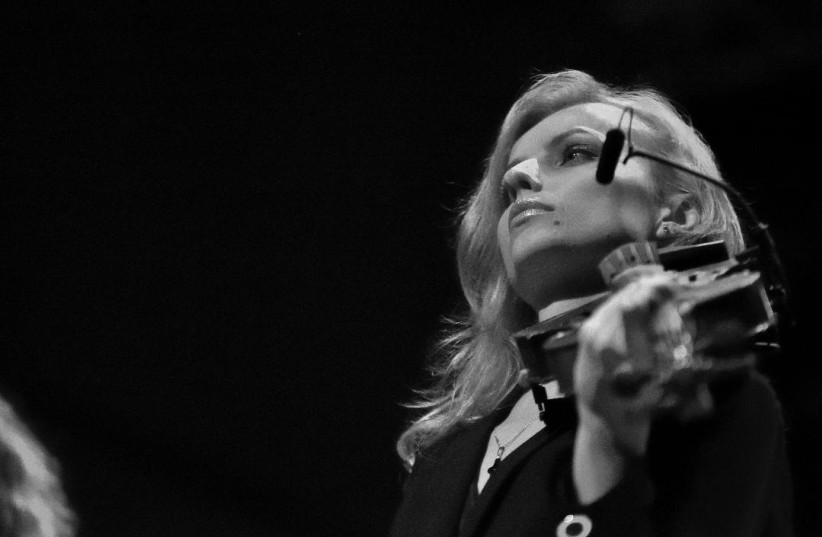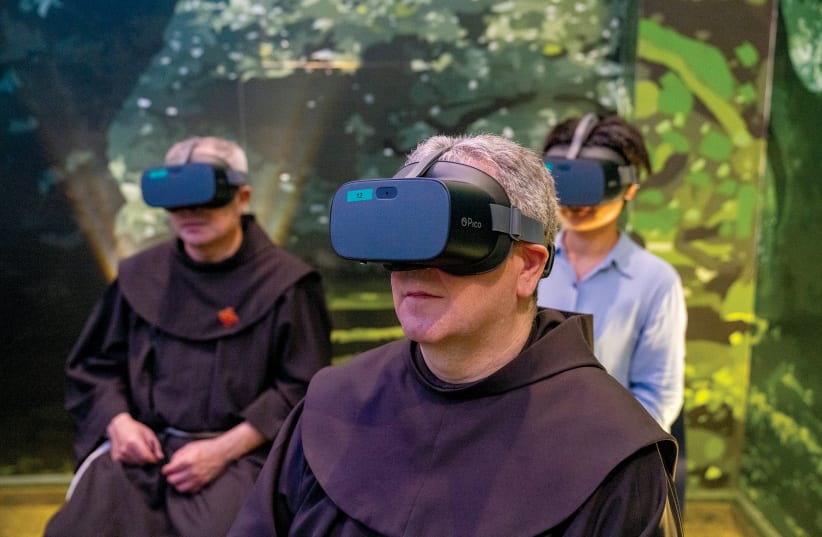The variety of hi-tech religious attractions beckoning Jewish and Christian visitors and pilgrims to Jerusalem keeps getting richer.
On July 13, after five years of work, Fr. Francesco Patton inaugurated the multimedia exhibition “The Experience of Resurrection” housed at the Franciscans’ Christian Information Center (CIC) located inside the Old City’s Jaffa Gate. The 200 sq. m. installation, spread over six rooms, takes 40 minutes to view. Visitors select from 13 languages to hear the multimedia presentation.
“The idea of this exhibition is to offer pilgrims more information about the City of Jerusalem at the time of Jesus and its transformations throughout history, with a particular focus on the Basilica of the Resurrection (the Church of the Holy Sepulchre),” said Patton, the Custos of the Holy Land, which has been representing Roman Catholics in the Land of Israel since 1217 when the order was founded by St. Francis of Assisi.
The Experience of Ressurection
“The exhibition is organized into six multimedia rooms. Two explain to pilgrims the events up to Jesus’s resurrection and three others explain what happened after the resurrection. The last room is a replica of the tomb of Jesus,” noted CIC director Fr. Tomasz Franciszek Dubiel.

- The first room includes a model of Jerusalem as it was 2,000 years ago. The topographic diorama gives a sense of the physical location of the Second Temple, the seat of Pontius Pilate at the Antonia Fortress, the Mount of Olives, and Golgotha – the Roman execution grounds.
- The second room – thanks to virtual reality – takes viewers to the Garden of Olives – also called Gethsemane, “the place of the olive oil press” – then to the slopes of Mount Zion where Peter denied Jesus three times before the cock crowed, and finally to Golgotha or Skull Hill. Wearing 3D goggles and sitting in swivel chairs, the 20 visitors are immersed 360 degrees in these sites and their historic atmosphere.
- The third room shows a film on the history of Jerusalem highlighting key personalities and events impacting the city from the Roman era to the present.
- The fourth room chronicles the 1,700-year-old Holy Sepulchre’s various stages of construction, demolition and rebuilding.
- The fifth room explains the “status quo,” the unwritten rule regulating the ownership, use of space and prayer times of the five denominations which have uneasily shared the site since 1852 when Ottoman Caliph Abdulmejid I in Istanbul ordered: “Things, as they have been running until today, shall remain as at present, pending a final agreement.” 170 years and still waiting...
- The sixth room features a reproduction of the rock-hewn tomb in which Jesus was laid on a Friday shortly before Shabbat came in at sunset, and from which Christians believe he was resurrected on Sunday morning.
“It’s really great,” said Matteo, a pilgrim from Italy. “It’s very fantastic and really realistic!”
Admission is NIS 30, and NIS 25 each for groups.
THE EXPERIENCE of Resurrection’s soundtrack, composed by Mateusz Kobialka of the Kraków Academy of Music, enhances visitors’ mystical experience.
“I’m a Catholic, of course. It was very emotional for me” to write the music, he said. “I tried to build everything in all six rooms into one piece.”
Enhancing his music is the violin playing of Dominika Rusimowska of Przemysl, Poland, a jazz and classical violinist who improvised with E-scale notes to give the music a haunting Oriental or Arabic ambiance.
The Experience of Resurrection is the Franciscans’ second educational attraction for Catholic pilgrims in Jerusalem’s Old City. In 2018, the brotherhood opened the Terra Sancta Museum in the Monastery of the Flagellation on the Via Dolorosa, dedicated to the archaeological and artistic heritage of Christianity in Israel. Like the CIC exhibition, it too includes a multimedia component apart from its archaeological section.
The museum’s third section, displaying the many treasures donated to the Franciscans over the centuries by the royal courts of Europe, will open in 2023 in a 17th-century cloister at the Monastery of St. Savior in the Old City’s Christian Quarter. Those artifacts were showcased in 2016-2017 at The Metropolitan Museum of Art in New York, in a landmark exhibition called “Jerusalem 1000–1400: Every People Under Heaven.”
The future wing will also display the so-called “Treasure of Bethlehem” – rare liturgical objects, mostly made of silver and brass, from the Crusader Period (1099-1291), which were discovered during the restoration of the rooms of the Franciscan Monastery St. Catherine “ad Nativitem” in Bethlehem between 1863 and 1906. The treasure, likely concealed to protect it from plundering by Mamluk Muslims, probably was part of the sacred furniture of the Church of the Nativity nearly a millennium ago.
“Every time they [archaeologists] find a discovery, it’s a new piece of your history.”
Sari Tahulian
The Big Bridge
JEWISH VISITORS to the Holy City who may have little interest in the Franciscans’ new attraction won’t want to miss “The Big Bridge,” the tour of a newly-exposed section of ancient underground Jerusalem operated by the Western Wall Heritage Foundation. Opened during Hanukkah 2021, the tour is distinct from the classic Kotel Tunnels route which parallels the Western Wall and emerges on the Via Dolorosa. In this new attraction, one explores Wilson’s Arch, an ancient bridge that carried Jewish pilgrims arriving at Herod’s Temple.
“Wow!” exclaimed Sari Tahulian, a guide at the site. “Every time they [archaeologists] find a discovery, it’s a new piece of your history.”
The monumental bridge was built both as an aqueduct and as a pilgrims’ entrance to the Temple, she explained. Likely first constructed by the Hasmoneans, it was modified under King Herod, and then perhaps again during the early Arab period by the Omayyads or the Abbasids, she said.
“People see something new. It’s a new perspective on the Kotel,” Tahulian said.
Tickets are NIS 38 for adults and NIS 25 for children. The tour takes an hour.
For another perspective on the Temple, this one in hyper-realistic 3D virtual reality, don’t miss the Western Wall Heritage Foundation’s “A Look into the Past.” David Keinan has worked at the site since it opened in 2017. “People like to see the Temple in 3D. It’s crazy. There’s a big demand.”
Like the Western Wall Tunnels, the entrance to the attraction is on the north side of the Western Wall plaza. Tickets for the 10-minute long experience are NIS 31 for adults and NIS 16 for children.
“Ten measures of beauty were given to the world; Jerusalem received nine while the rest of the world received one.”
Kiddushin 49a-b
These four sites, two Jewish and two Christian, allow visitors to appreciate the hyperbole of the Talmudic sages who declared: “Ten measures of beauty were given to the world; Jerusalem received nine while the rest of the world received one.” (Kiddushin 49a-b)
Today it’s all available in air-conditioned, sometimes virtual splendor. ❖
